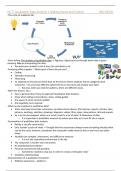HC 7: Qualitative Data Analysis I: Making Sense and Coding (05/10/23)
-The circle of academic life:
-Story telling; The analysis of qualitative data -> Rigorous, logical process through which data is given
meaning. You are interpreting the data.
• You want your analysis to tell a story (or contribute to it).
-Analyzing office supplies – What types of items do you see? …
• Coding
• Thematic structuring
• Theorizing
• So, depends on the person (think back to the lecture where students had to categorize desk
materials) -> So, you have different options/forms to structure and analyze your data!
o But also, when you look for patterns, there are different views.
-After this lecture, you…:
• Have a general idea of how to approach Qualitative Data Analysis.
• Know what coding is (procedures, steps, coding guide).
• Are aware of some common pitfalls.
• Are hopefully more inspired.
-What can be analyzed in qualitative data?
• Texts, interview transcripts summaries, narrative stories diaries, life histories, reports, articles, tales,
pictures, paintings, sketches, drawings, diagrams, videos, films, plays, observations, talk and sounds.
• So, a lot can be analyzed, which as a result, leads to a lot of data! → Reduction of data
o It is important in qualitative research to reduce your data as it must fit into a report.
-Assumptions of qualitative data analysis:
• Reality is socially constructed.
• Emic (insider's point of view) -> Thought that the researchers always know everything already (what
can be the case), however, sometimes the researcher really needs to dive in and try to see other
views.
• Variables are complex, interwoven, and difficult to measure.
o It is not the controlled environment in the lab.
• The researcher is his/her own instrument.
• No standardized procedures
• Personal involvement and partiality
o Sometimes needed to step out in order to create a helicopter view!
• Empathic understanding
-Characteristics of a qualitative researcher:
• Reflexive awareness – ability to:
, o Think abstractly
o Step back and critically analyze situations
o Recognize the tendency towards bias
• Openness
o Be flexible and open to helpful criticism.
o Appreciative inquiry -> That the interviewee really thinks that the interview was worthy or
helped to create new thoughts about certain things, such that the interviewee feels content!
• Sensitivity -> Sensitive to the words, interpretations, and actions of respondents
o If the interviewee/people in focus groups name certain words a different way (“Oh they call
it this way”)
-When to think of analysis? -> Starts already during the research design!
• During design: Devising frameworks, interview guides -> Constructing ways of looking, ways of
understanding.
• During data collection -> Questioning, probing, co-construction of meaning
• Desk analysis afterwards
o Coding the responses and discussions
o (Re-)construct relevant concepts and themes.
o Organize around core generalizations or ideas.
-Qualitative analysis principles:
1. Noticing concepts (being open)
2. Collecting examples of these concepts
3. Analyzing these concepts in order to find commonalities.
-Different types (degrees) of analysis: (see arrows on top right)
• Content analysis -> The purpose is to describe the characteristics of the document's content by
examining who says what, to whom, and with what effect and make inferences (may contain
quantitative elements).
o More descriptive and more often structured
• Thematic analysis -> Thematic analysis as an independent qualitative descriptive approach; mainly
described as a method for identifying, analyzing and reporting patterns (themes) within data.
o Goes deeper!
• Grounded theory -> The construction of theory through the open analysis of data.
o More open interpretation.
o Goes even more deep! You start from scratch.
− There are no clear boundaries in types of analysis!
− Content and thematic analysis are sometimes used interchangeably, but grounded is really
something different.
,-Codes -> Word(s) or short phrase(s) that represent(s) the essence or key attribute of narrative/verbal
information.
• Used to categorize data.
• Coding is the process of organizing the data into ‘chunks’ (segments) that are alike.
• Codes are developed into a ‘coding structure/guide’ -> So that you cluster the things you find
important for your research in the same code! So, you also define what these codes are then.
• For example, the first part of interview, is not actual wanted data, but just getting to know the
interviewee, so you can now ‘code’ this whole paragraph as ‘introduction’.
-Code structure / coding guide
• Compilation of emerging codes
• Brief definitions or properties for each code (can also include illustrative coded pieces / quotes)
o Which words can be placed under which code.
• Provides guidance for when and how to use the codes.
• Will evolve throughout the analysis (refining)
• You continuously have discussions with your research team.
-Example of coding an interview transcript:
• The actual codes are: cognitive, social/interpersonal etc (so 4 codes)
-Another example with different levels of codes:
, -Coding often is during data analysis, also before, but especially during!
-Quotations: (what somebody said) (Why are they relevant?)
• Brings reader to reality of the situation.
• Support your analysis and findings.
• Illustrative
• Show range of issues
• Opposing views (between stakeholders)
• Do think of anonymity
-Qualitative analysis steps:
1. Data Curation → Transcribe (-> typing) (interviews, field notes, etc.)
a. Curation -> When it is done in a different language, or half recorded, or digitalize your field
notes.
2. Collect - code - collect - code etc. (Familiarization)
3. Read and re-read... suspend initial interpretation.
a. Focused reading and open coding -> You start blank
4. Close examination, label text with keywords. Reviewing and axial coding.
a. Axial coding -> You already have a few codes and look if others are related
5. Modify codes, remove duplications, hierarchical order, integrate theory. Generate theory!
6. Look for connections that emerge from the data. Selective coding.
a. Selective coding -> Go back in the data and check certain things very specific.
-Approach; deductive or inductive or in the middle




